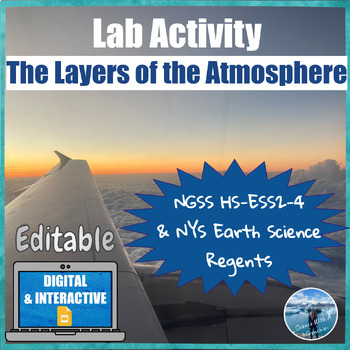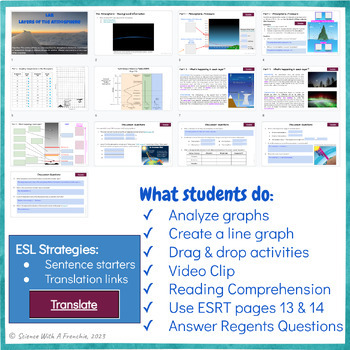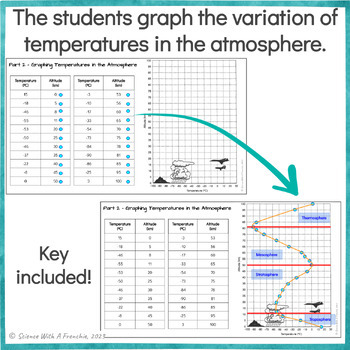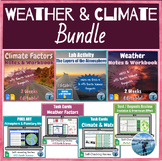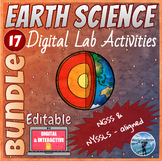Layers of the Atmosphere | Digital Lab Activity | Editable | NGSS
- PDF
- Google Apps™

What educators are saying
Also included in
- This one-month-long meteorology and climate bundle covers everything your students need to know about weather and climate for the New York State (NYS) Regents exam. It includes guided notes with practice questions, teacher presentations, a digital and interactive lab activity, and 4 self-checking diPrice $35.50Original Price $43.50Save $8.00
- These digital Earth and Space Science lab activities are ideal for topics where hands-on lab activities may be difficult to complete. They are aligned with NGSS and the New York State (NYS) Earth Science curriculum to prepare the students for the Regents exam. All the labs are editable and interactiPrice $43.50Original Price $57.50Save $14.00
Description
In this Google Slides™ digital lab activity, the students will explore the properties of Earth’s Atmosphere. They will understand how the atmosphere is divided into layers based on temperature changes at different altitudes. They will describe the structure of Earth’s atmosphere and investigate temperature, density, and pressure changes in the different layers. In addition, they will identify the meteorological and astronomical phenomena that occur in each layer of Earth’s atmosphere. This is an interactive lab activity with links to online simulations and drag & drop features. There is also a BrainPop video (in English or Spanish) to provide some background about the atmosphere to the students. BrainPop requires a subscription; however, if your district doesn’t have one, you can find the video on YouTube.
ESL Strategies: This lab activity is scaffolded for English Language Learners (ELLs):
- Each slide contains a “Translate” hyperlink button to translate the text into any language supported by Google Translate.
- It includes sentence starters to help ELLs structure their answers. The document is editable so you can remove the sentence starters if your students don’t need them.
Standards: The level of this lab is perfect for 8th grade or high school. This lab activity aligns with:
- NGSS MS-ESS2-5: Collect data to provide evidence for how the motions and complex interactions of air masses result in changes in weather conditions.
- NGSS HS-ESS2-4: Use a model to describe how variations in the flow of energy into and out of Earth’s systems result in changes in climate.
- New York State Physical Setting/Earth Science Core Curriculum 2.1b - The transfer of heat energy within the atmosphere, the hydrosphere, and Earth’s interior results in the formation of regions of different densities. These density differences result in motion.
Editable: You can edit the text of this lab activity by clicking on “View” → “Theme Builder”. However, due to Term of Use agreements with clip art artists, some of the background images aren’t editable.
Digital: This digital lab activity was created with Google Slide. It can be used in person or for distance learning. Share the Google Slides with your students via your Google Classroom. Make sure you select “Make a Copy for Each Student” while you are creating the assignment.
Related Products:
- Notes & Workbooks:
⭐ Earth's Spheres and Layers | Notes and Workbook | Editable
⭐ Weather Notes and Workbook | Meteorology Unit | Editable
⭐ Climate Factors Notes and Workbook | Meteorology Unit | Editable
- Reviews:
⭐ Weather & Meteorology Task Cards | Earth Science Regents Review | Digital
⭐ Weather & Meteorology Vocabulary Review | Color by Number
⭐ Atmosphere and Planetary Winds | Digital and Self-Checking Pixel Art Review
⭐ Climate and Water Task Cards | Earth Science Regents Review | Digital
⭐ Insolation & Greenhouse Effect | Regents Review | Digital | ESRT page 14
- Save with Bundles:
⭐ Weather & Climate Bundle for NYS Earth Science
⭐ NYS Earth Science Digital Lab Activities | Growing Bundle
⭐ NYS Earth Science Digital Regents Reviews | Growing Bundle
⭐ NYS Earth Science Vocabulary Reviews | Color-by-Numbers
Follow me for notifications about new resources coming soon!
Find me on Instagram!

